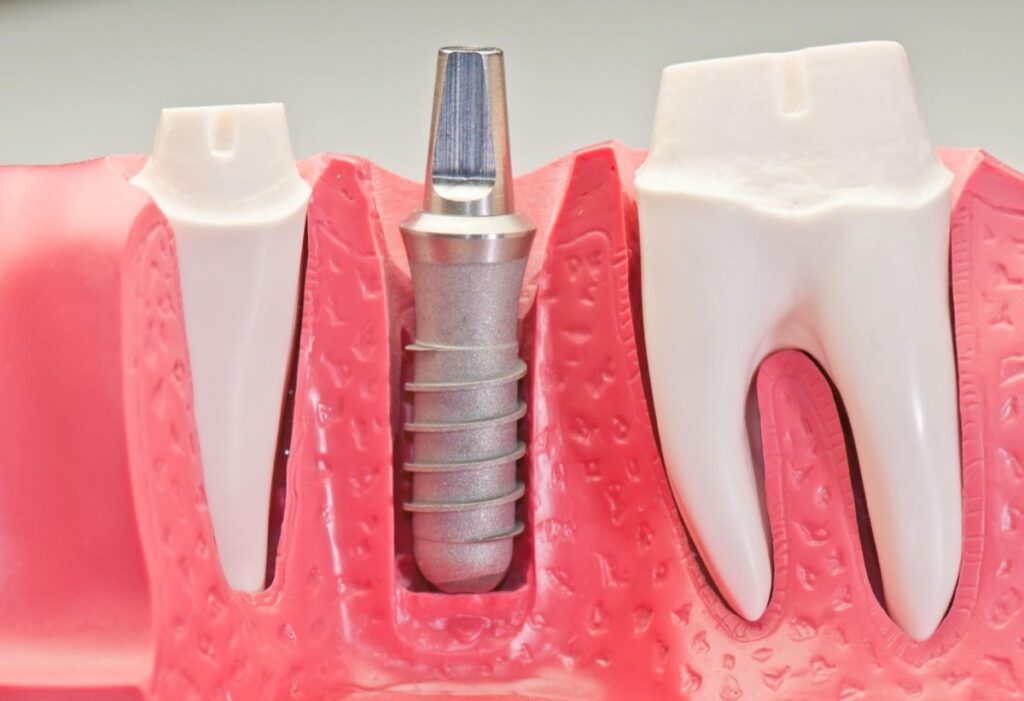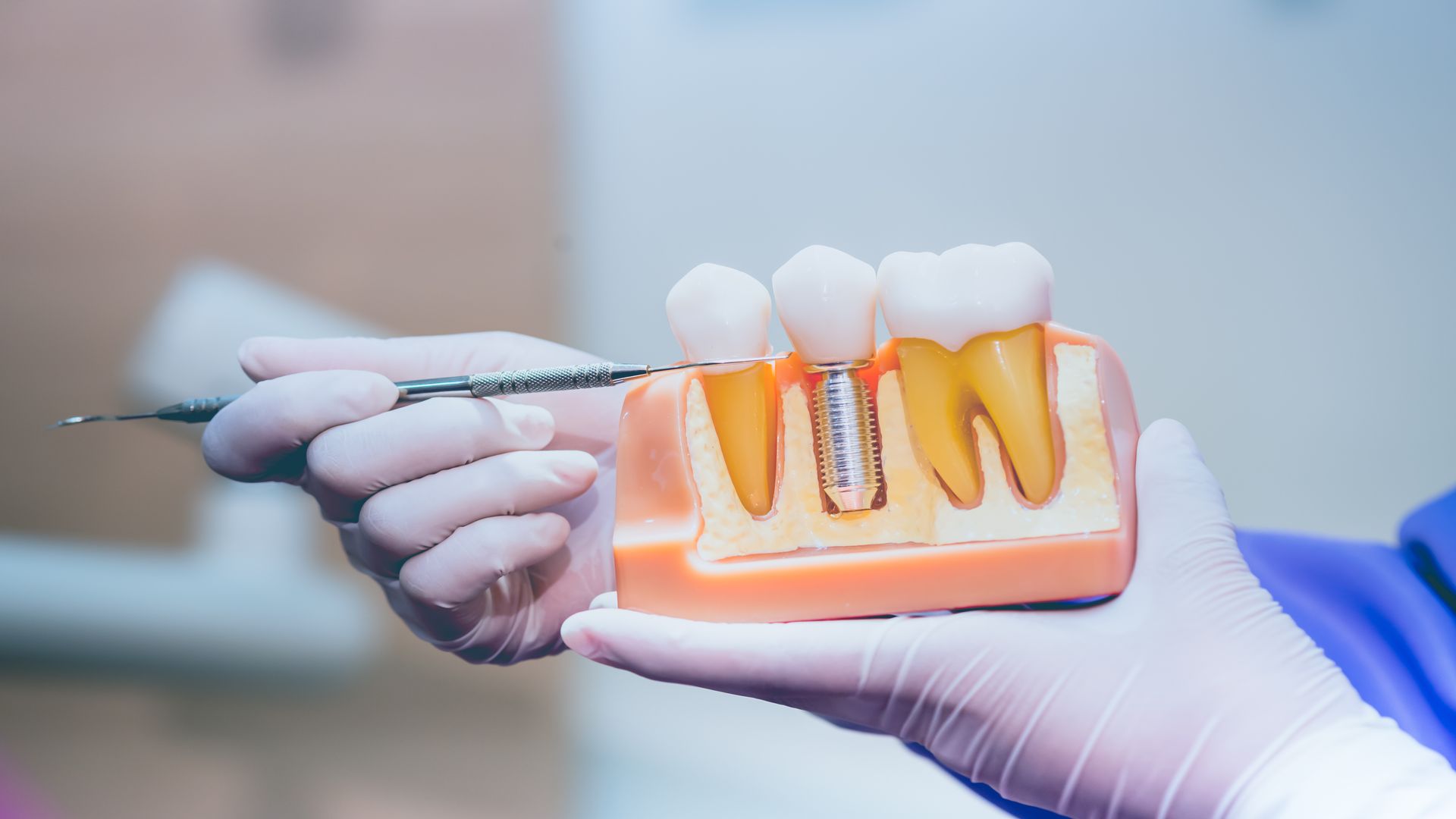Replacing and fixing teeth for health and aesthetic purposes has existed for a long time and is a common practice among most people. These methods can range from simple cleaning, removing, or pasting. Other methods can include realignment of teeth using aligners or installing braces. But for those needing replacement, an oral surgery called a dental implant may be necessary.
What Are Dental Implants?
A dental implant (also known as fixtures) is an artificial part implanted in a person’s bone such as the jaw or skull for a dental prosthesis like the bridge, crown, denture, orthodontic anchor, or facial prosthesis. Materials such as titanium or zirconia are molded and shaped to bond with the bone fittingly, based on the biological process of osseointegration. This is the similar idea that implants and prosthetic limbs apply to, where new bone is placed directly on the implant surface and that implant allows mechanical stability.
For dental implant, the implant fixture is set first for it to osseointegrate. The osseointegration process needs a great time for healing and once it has healed, then a dental implant or prosthetic will be added.
Usually, an implant is of three parts – the crown, the abutment, and the implant post. The height can be made from a wide variety of materials. Ceramics and porcelain are used for natural-looking implants, while some prefer gold, silver, or metal alloys for other purposes. This is the visible part of the implant that’s on the surface. The abutment is the connector piece that joins the crown and the implant post. These are placed at different angles depending on the implant post’s purpose and alignment. The third part that goes in the jaw or the bone is the implant post, which is a small, cylindrical screw. They rely on osseointegration to allow the bone to fuse with the implant over time.
History Of Dental Implants
Throughout history, dental implants have been done in different parts of the world, each with distinct methods but serving the same purpose of filling the gap where a permanent tooth is missing. Four thousand years ago, Chinese people used bamboo pegs for missing teeth, fixing the bone into the mouth. Two thousand years after, the Egyptians carved precious metals and implanted them in the jawbone, which is found in historical records of their kings. Other archeological finds have also located cases of artificial teeth made from elephant ivory or jade.
In today’s dental medicine, Dr. Per-Ingvar Brånemark of Sweden discovered the osseointegration properties of titanium to bones and conducted the first tooth replacement with the same metal in 1965. He then published journals about this successful surgery, and modern dental institutions such as Thevillagedentalcenter.com followed the idea of the implant as time progressed.
Benefits Of Dental Implants
Millions of people get dental implants for various purposes every year. If you’re considering getting one for yourself or want to know the good things about getting one, here are some factors that can help you decide on your next dentist’s appointment. You can click here for the best dental implants in Hicksville.
Dental Implants Last for A Long Time
Dental implants are a permanent solution for the loss or lack of teeth inside the mouth. Since the implant is fused permanently to the bone, it can last for 20 to 30 years. Still, their lifespan is based on one’s oral hygiene and dental habits. The crown is usually the part that weathers over time, but it also depends on the material used for this part.

To ensure longevity, a person with implants needs good dental care for their new prosthetic tooth. Dental implants are assured to be long-lasting, and even archeological finds can stand that people in the past who had dental implants in them still have them intact even after death. Compared to dentures, these implants can be installed for decades without needing to replace them every few years.
Dental Implants Are Low Maintenance
In comparison to dentures, dental implants need less maintenance. Caring for your implants usually doesn’t differ from caring for your natural teeth – brushing them at least twice a day, flossing for hard-to-reach places, and visiting the dentist for an appointment every once in a while, to ensure good dental health. They don’t need unique products or adhesives, so you don’t need to worry about them being misplaced or breaking.
Dental implants can also withstand a good amount of force, and you don’t have to worry about breaking them from biting things that your regular teeth can. Modern dental implants made with titanium or ceramic can also offer the increased stability that regular teeth have. These are low maintenance and taking care of these dental implants is effort and cost friendlier than other alternatives.
Having Dental Implants Prevent Bone Loss in the Jaw
Bone loss is a common occurrence for missing teeth. After the first year of losing a tooth, 25% of the surrounding bones wear out and will continue to do so over time. By replacing your teeth with dental implants, the jaw bone keeps its natural shape and allows it to keep its structure.
Osseointegration, the process involved in dental implants, allows the gap in the teeth to be filled by the implant and surrounds it with bone afterward, creating a structure without having holes that can further weather the bone. Also, over time, implants can help restore and retain bone in the jaw and restore its original density. Dental implants mimic the natural shape, structure, and space filled by a tooth, so the sides of the bone won’t be exposed, therefore, they don’t wear off over time.
The Material Look and Feel Like Natural Teeth
As stated earlier, modern dental implants use ceramic and porcelain for the crown or the visible part of the implant. Over time, these materials’ color, texture, and look have to look the same as natural teeth. Usually, these are preferred by many people who get dental implants for aesthetic purposes, making the prosthetic not noticeable and natural looking. Aside from the physical benefits of dental implants, having a complete set of teeth can also improve someone’s self-esteem and regain the healthy smile most people want to achieve.
They Can Function Similarly to Natural Teeth
Since dental implants’ goal is to mimic the look and purpose of natural teeth, a person with dental implants can use their teeth the same way. They can chew, bite, eat, and do the same routine as natural teeth. This is due to the composition of the crown that’s similar to the properties of natural teeth and the stability of the implant’s base once osseointegration takes place.
Still, good dental habits such as not forcing the teeth to bite too hard and taking care of them are highly advised to prevent rapid weathering of the implanted dental prosthetic. Otherwise, the person can eat and chew just fine.
Drawbacks Of Dental Implants
As with any medical procedure, dental implants aren’t guaranteed to have 100% success, as negative factors can emerge over time depending on the implant, the person, and the process. Consider these negative factors first before deciding that a dental implant is a good choice for you.

Dental Implants Are Costly
Undeniably, a dental implant is expensive, and you may need a reasonable budget to consider the procedure. Since this is a lifelong investment, it can be pricy for many people. It generally costs US$1,500 to US$2,000 per implant in the US. The cost of the procedure, pre-operation, and post-operation care isn’t included in this, which may bump the price from US$3,000 to US$4,800. This price can still vary depending on case-to-case bases, the length of the procedure, needed actions, and other miscellaneous fees. Overall, you may need to consider having a reasonable budget before undergoing this procedure, weighing the pros and cons, and allowing yourself alternatives if dental implants are too costly.
A Need to Meet a Set of Requirements Before Getting the Procedure
A dental implant isn’t offered upfront to a person visiting the dentist; there are several requirements to be a candidate for the installation of a dental prosthesis. A person must first have one or more missing permanent teeth, a jawbone that has reached total growth, which is why it’s limited to adults only. They also need an adequate and suitable bone structure that can hold and secure the implant or allow osseointegration and bone graft. The person is also required to have healthy oral tissues and has no present medical conditions that will prevent or affect bone healing. People who want dental implants may be offered to wear and use dentures first, and oral surgery may proceed if a person can’t or doesn’t want the dentures. They are also required to commit to several months to complete the process, and the person mustn’t smoke, which can significantly affect their dental health. Usually, if some of the necessary conditions aren’t met, they won’t perform a dental implant on their patient.
Having Dental Implants Require Surgery
Chicago dental implants fall under the category of invasive oral surgery. This can mean that you may need to qualify for surgery first before undergoing this procedure and know all the risks that surgery has. Dental implant procedures may have a chance of getting an infection at the implant site, injury or damage to oral structures such as the bone or blood vessels during the procedure or afterward, nerve damage, and possible sinus problems. Also, during the osseointegration process, the body can reject the implant’s material and cause further complications. Be sure to check your overall health first and ensure you are fit to undergo surgery without underlying health risks that can affect you and cause further damage instead of providing help and a solution to your dental problem.
The Whole Procedure Can Be Extensive
Dental implants require a lot of time and aren’t a quick fix. This procedure takes several months to complete, depending on the case. First, if you need a replacement for an existing damaged tooth, you must have it removed first, and the site must be healed.
Afterward, preparation for the tooth site with fitting and implanting the anchor is done first, and you need to have several months of a waiting period during the bone healing or osseointegration stage, which can last from 1 to 6 weeks, making sure that the body accepts the material and does not reject or cause complication.

Finally, when the site is ready, the dental implant is placed. You need a commitment for an extended period as these procedures can’t be rushed, and you need to give your body time to heal naturally. You can consider alternatives if you need a quick fix or schedule so that it doesn’t significantly affect your work, school, or life.
May Require Supplemental Procedures Depending on the Case
Aside from putting the dental implant itself, other procedures may be done first during the whole process for different reasons. One is tooth extraction, or removing a damaged tooth to prepare the site for a dental implant. Other procedures may include bone grafting or sinus lift, usually done for teeth that have been missing for a long time. These procedures require surgery which can further alleviate the risk, time of healing, and cost. Weigh out your options and consider these factors very well first before getting dental implants.
Statistics Of Failure And Success Of Dental Implants
Over the past ten years, millions have had a 90% to 95% success rate in dental implant procedures. It’s estimated that only 5% to 10% of people getting implants fail over the years, which is significantly low compared to its success rate. It’s essential to find a reliable and excellent doctor to allow them to perform this procedure on you, and it’s up to you to commit to this in the process of getting dental implants.
Conclusion
Getting a dental implant is both a commitment and a significant procedure for you and for your health that’s now available for you to undergo. Before deciding if the process is for you, consider first the positive and negative factors of the procedure as well as if it’s something you’re willing and capable of doing. Nevertheless, a dental implant is good for your health and achieving that good-looking smile after the procedure.
